

Good lighting is essential for the well-being of body and mind, in addition to the fact that lighting fixtures can be important design elements for residential spaces. Scientifically validated bio-adaptive lighting solutions enhance guests’ sense of comfort in any environment.
Reduce light levels in the evening to promote better sleep and provide low-level lighting on the way to the bathroom at night to minimize sleep disturbances. So simulate a natural awakening at the beginning of the day and charge up with energy and good mood with the right light at the beginning of the day.
The benefits of bioadaptive lighting
The rotation of the earth on its axis generates these cycles that control some processes of our body, such as the regulation of body temperature, heart rate and the production of some natural substances such as cortisol and melatonin that regulates the alternation of sleep and wakefulness, or what we know as “circadian rhythm” (an etymology derived from the Latin that means about, “around” and dies, “day”).
Approximately 80% of environmental information comes to us from sight, through the ganglion cells inherent in the retina. Hence the importance of choosing light colors that give the walls a greater sense of spaciousness of the rooms and therefore less oppression, as well as large windows possibly oriented towards relaxing green areas.
How building intelligence works
Although we can count on good lighting levels indoors, from the point of view of our internal clock this may not be the case. In response to this, today manufacturers of lighting devices have put on the market various models, mainly with LED lights, in which you can vary the color temperature from a white with a greater presence of blue to a white with a greater presence of red and even vary the light emission during the day.
These are building intelligence solutions, i.e. measures that allow the building, in partial or total autonomy, to adapt intelligently to the needs of those who live in it or live in it temporarily. These luminaires can be supplemented with presence sensors and daylight sensors and thus benefit our body’s response to these changes.
To wall switches rather than lamp switches that can be positioned as desired, it is possible to apply dimmers or dimmers to adjust the light intensity of the source. The dimmers can also be managed autonomously according to precise schemes managed by software, which provide for the variations in an automated way according to criteria that can also be programmed by the user.
The recent advent of smart speakers is acting as a driving force for a rapid spread of light calibrations, with the spread of smart bulbs connected via Wifi to the speaker to allow easy control with simple voice commands or through dedicated multi-platform apps. A small revolution of the most expensive and traditional home automation systems, for the home control of many.
TID nasce con un grande obiettivo: creare un network in grado di far circolare le idee più giovani e creative nell’attuale panorama del design rendendo così più efficace e semplice l’incontro tra domanda e offerta. Giovani designer e architetti possono caricare online i propri lavori, a fianco di quelli dei professionisti già affermati, creando una proposta unica nel panorama mondiale: un’infinità di idee, spunti, proposte che ti aiuteranno ad arredare casa, ufficio, locali, seguendo le idee più attuali e interessanti.